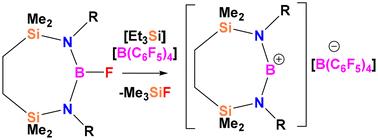一种螯合硼阳离子
IF 3.3
3区 化学
Q2 CHEMISTRY, INORGANIC & NUCLEAR
引用次数: 0
摘要
双配位硼阳离子非常罕见。在此,我们报告了通过 BF3 与相应的二硫化二酰胺反应合成 [RNSiMe2CH2]2BF (R = Dipp 3, 1-Ad 5)(Dipp = C6H3(iPr)2,Ad = C10H15)的过程。随后的氟化物萃取提供了相应的硼盐:[(RNSiMe2CH2)2B][B(C6F5)4](R = Dipp 6,1-Ad 8)。前者已经生成,而后者则证明可以分离,并具有晶体学特征。本文章由计算机程序翻译,如有差异,请以英文原文为准。

A chelated borinium cation†
Two coordinate boron cations are rare. Herein we report the synthesis of [RNSiMe2CH2]2BF (R = Dipp 3, 1-Ad 5) (Dipp = C6H3(iPr)2, Ad = C10H15) via the reaction of BF3 with the corresponding dilithiated diamides. Subsequent abstraction of fluoride provided the corresponding borinium salts, [(RNSiMe2CH2)2B][B(C6F5)4] (R = Dipp 6, 1-Ad 8). While the former was generated, the latter proved isolable and was crystallographically characterized.
求助全文
通过发布文献求助,成功后即可免费获取论文全文。
去求助
来源期刊

Dalton Transactions
化学-无机化学与核化学
CiteScore
6.60
自引率
7.50%
发文量
1832
审稿时长
1.5 months
期刊介绍:
Dalton Transactions is a journal for all areas of inorganic chemistry, which encompasses the organometallic, bioinorganic and materials chemistry of the elements, with applications including synthesis, catalysis, energy conversion/storage, electrical devices and medicine. Dalton Transactions welcomes high-quality, original submissions in all of these areas and more, where the advancement of knowledge in inorganic chemistry is significant.
 求助内容:
求助内容: 应助结果提醒方式:
应助结果提醒方式:


